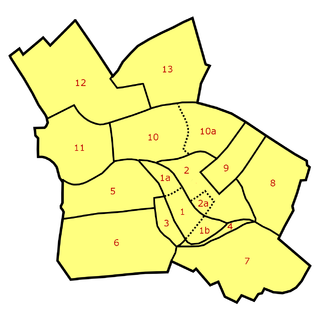
The Nikolaiviertel is an old quarter of the German capital of Berlin, founded c. 1200. Together with nearby Cölln, they jointly make up Alt-Berlin, the reconstructed historical heart of the city. Located in the Mitte locality, it is five minutes away from Alexanderplatz.
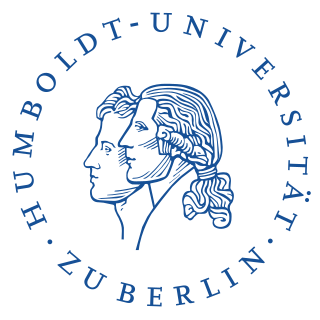
The Humboldt University of Berlin is a public research university in the central borough of Mitte in Berlin, Germany.
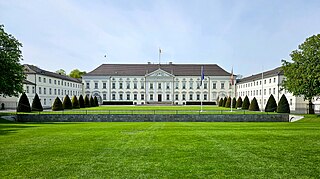
Bellevue Palace, located in Berlin's Tiergarten district, has been the official residence of the president of Germany since 1994. The schloss is situated on the banks of the Spree river, near the Berlin Victory Column, along the northern edge of the Großer Tiergarten park. Its name – the French for "beautiful view" – derives from its scenic prospect over the Spree's course.

The German Chancellery is an agency serving the executive office of the chancellor of Germany, the head of the federal government, currently Olaf Scholz. The Chancellery's primary function is to assist the chancellor in coordinating the activities of the federal government. The head of the Chancellery holds the rank of either a Secretary of State or a Federal Minister, currently held by Wolfgang Schmidt. The headquarters of the German Chancellery is at the Federal Chancellery building in Berlin, which is the largest government headquarters in the world.

The Neue Wache is a listed building on Unter den Linden boulevard in the historic centre of Berlin, Germany. Erected from 1816 to 1818 according to plans by Karl Friedrich Schinkel as a guardhouse for the Royal Palace and a memorial to the Liberation Wars, it is considered a major work of Prussian Neoclassical architecture. A Victoria pedimental sculpture by Johann Gottfried Schadow and five General statues by Christian Daniel Rauch, referring to the Warrior statues on Schlossbrücke, also belong to the ensemble. Since 1993, the Neue Wache has been home to the Central Memorial of the Federal Republic of Germany to the Victims of War and Tyranny.

The New Palace is a palace situated on the western side of the Sanssouci park in Potsdam, Germany. The building was begun in 1763, after the end of the Seven Years' War, under King Friedrich II and was completed in 1769. It is considered to be the last great Prussian Baroque palace.

The Grand Ducal Palace is a palace in Luxembourg City, in southern Luxembourg. It is the official residence of the grand duke of Luxembourg, and where he performs most of his duties as head of state of the grand duchy, though his principal residence is Berg Castle, in Colmar-Berg.

The Palais Strousberg was a large city mansion built in Berlin, Germany for the railway magnate Bethel Henry Strousberg. It was designed by the architect August Orth and built between 1867–68 at No.70 Wilhelmstraße. The grandiose splendour of its accommodation and novel integration of the latest building technologies into the fabric of the building, ensured that Berliners would still find the Palais impressive decades after its construction, becoming the model of refined luxury in Berlin architecture.

The Harnack House in the Dahlem district of Berlin, Germany was opened in 1929 as a centre for German scientific and intellectual life. Located in the intellectual colony of Dahlem, seat of the Free University Berlin, it was founded by the Kaiser Wilhelm Gesellschaft (KWG) on the initiative of its first president, the theologian Adolf von Harnack, and of its then chairman, Friedrich Glum. The project was supported politically by the Weimar Republic Chancellor Wilhelm Marx and Foreign Minister Gustav Stresemann, and an influential Centre Party deputy Georg Schreiber. The land for its construction was donated by the state of Prussia, and the costs of building and furnishing the house were defrayed partly by the government, and partly by public subscription.
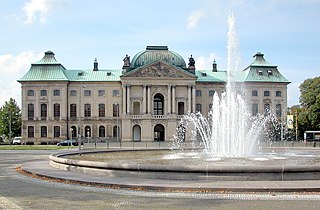
The Japanisches Palais is a Baroque building in Dresden, Saxony, Germany. It is located on the Neustadt bank of the river Elbe.

The Ordenspalais was a building on the northern corner of Wilhelmplatz with Wilhelmstraße in Berlin.

The Marmorpalais is a former royal residence in Potsdam, near Berlin in Germany, built on the grounds of the extensive Neuer Garten on the shores of the Heiliger See. The palace was commissioned by King Frederick William II of Prussia and designed in the early Neoclassical style by the architects Carl von Gontard and Carl Gotthard Langhans. Despite the name, brick is the main material. The palace remained in use by the Hohenzollern family until the early 20th century. It served as a military museum under communist rule, but has since been restored and is once again open to the public.

The Prinz-Albrecht-Palais was a Rococo city palace in the historic Friedrichstadt suburb of Berlin, Germany. It was located on Wilhelmstrasse 102 in the present-day Kreuzberg district, in the vicinity of Potsdamer Platz.
The Ernst Busch Academy of Dramatic Arts, located in the Niederschöneweide district of Berlin, Germany, was founded in 1951 as the National Theatre School in Berlin with the status of college. In 1981, it was granted university status, and a year later it was renamed after the singer and East German actor Ernst Busch.

Babelsberg Palace lies in the eponymous park and quarter of Potsdam, the capital of the German state of Brandenburg, near Berlin. For over 50 years it was the summer residence of Prince William, later German Emperor William I and King of Prussia and his wife, Augusta of the House of Saxe-Weimar-Eisenach, German Empress and Queen of Prussia. Along with the surrounding park and other parks in the area, the Babelsberg Palace was inscribed on the UNESCO World Heritage list in 1990 for its architectural cohesion and its testimony to the power of the Prussian monarchy.

The Borsig Palace was an iconic building at the corner of Voßstraße and Wilhelmstraße in the center of Berlin and one of the grandest Italianate villas in Germany. Completed in 1877 for industrialist Albert Borsig, who died before he could move in, the building served for a time as a bank. In 1933 it became the residence of Vice-Chancellor Franz von Papen, where dramatic scenes relating to the Night of the Long Knives would play out just one year later. In the aftermath, Palais Borsig was converted into the new headquarters of the Sturmabteilung on Adolf Hitler's direct orders. It was then integrated into the New Reich Chancellery by Albert Speer in 1938. The palace was severely damaged in World War II and, together with Hitler's Chancellery, demolished by the Soviet forces in 1947.
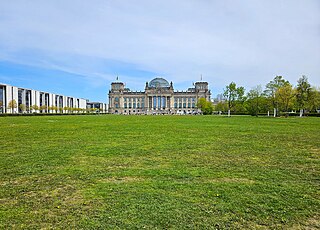
Platz der Republik is a square in Berlin, Germany. It is located in the Tiergarten, directly in front (west) of the Reichstag building. The square has an area of about 36,900 square meters and is almost completely covered by grass but is decorated with some hedges and a few trees.

The Kronprinzenpalais is a former Royal Prussian residence on Unter den Linden boulevard in the historic centre of Berlin. It was built in 1663 and renovated in 1857 according to plans by Heinrich Strack in Neoclassical style. From 1919 to 1937, it was home to the modern art collection of the National Gallery. Damaged during the Allied bombing in World War II, the Kronprinzenpalais was rebuilt from 1968 to 1970 by Richard Paulick as part of the Forum Fridericianum. In 1990, the German Reunification Treaty was signed in the listed building. Since then, it has been used for events and exhibitions.

The Palais am Festungsgraben, originally known as the Palais Donner, is a stately building in Berlin’s Mitte subdistrict located behind, and facing, the ensemble of chestnut trees around the Neue Wache, near the eastern terminus of the boulevard Unter den Linden. The name refers to its construction next to a redundant canal, gradually filled in by 1883, which had originally been a moat surrounding the 17th century city wall. Built as a private residence, it later housed a succession of Prussian government offices, and after World War II various cultural institutions in the Soviet sector of Berlin. After administrative authority was transferred to the newly established German Democratic Republic (GDR) in 1949 it hosted a succession of institutions established to further German-Russian contacts. Since German reunification it has accommodated a theater and from 2004 an art gallery.

The Reich President's Palace was from 1919 to 1934 an official residence of the President of the Reich and the official seat of the German head of state.























